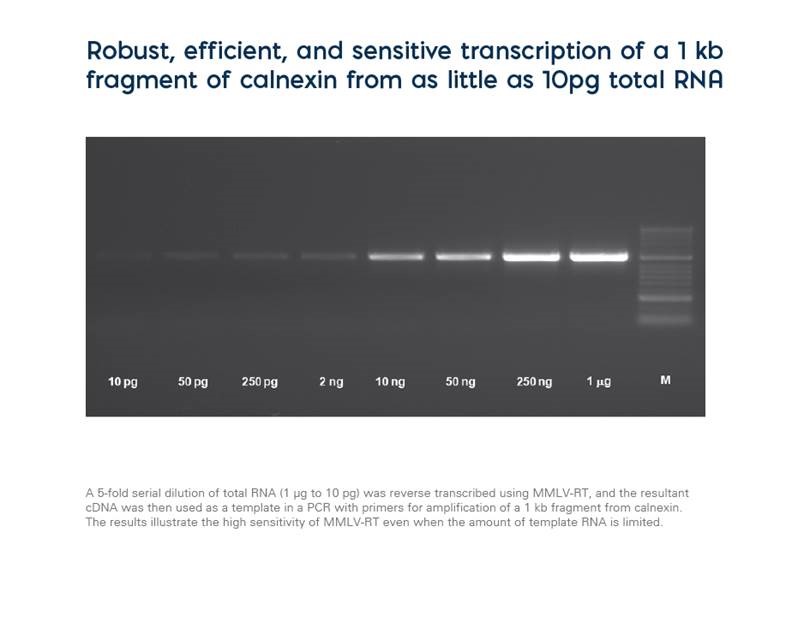
MMLV-RT, MDX044
For cDNA synthesis and subsequent PCR or qPCR in a one-step or two-step assay.
文档与资源
Description
MMLV-RT is a high-quality reverse transcriptase that synthesizes a complementary DNA (cDNA) strand from mRNA or total RNA. With higher thermostability and reduced RNase H activity, it can be used for synthesis with long messenger RNA templates with high sensitivity and efficiency and is ideal for detecting low-level target genes.
Specifications
| Description | MMLV-RT (Moloney Murine Leukemia Virus Reverse Transcriptase) is used for cDNA synthesis and subsequent PCR or qPCR in a one-step or two-step assay. |
| Concentration | 100x |
| Appearance | Clear, colorless solution |
| Application | cDNA synthesis, RT-PCR, PCR, two-step RT-qPCR, one-step RT-qPCR |
| Sample type | RNA |
| Presentation | 1 vial |
| Storage | -20 °C |
| Mix stability | See outer label |
| Consistency | ± 0.5 Ct variance between test and reference sample |
| DNA contamination | None detected in PCR amplification with traces overlay with the negative control on E. coli and mouse genomic DNA specific targets. |
| DNase/RNase Contamination | No detectable degradation |
产品资料
分子诊断的原料试剂解决方案分子诊断的原料试剂解决方案
FAQs: MMLV-RT
For RNA with very high secondary structure we recommend using 55C MMLV-RT (MDX117), this reverse transcriptase can be used at temperatures up to 60°C which improves the cDNA yield from difficult RNA targets that require higher temperature to denature strong secondary structures.
Avoiding ribonuclease contamination is of primary concern since high quality template RNA is required. You can add RNase Inhibitor (MDX056), alternatively we also have RNase-Tolerant MMLV-RT (MDX043) which includes an RNase inhibitor.
If you are going to make cDNA, you will require a buffer that contains 0.2 mM each dATP, dCTP, dGTP & dTTP, 10 mM DTT (dithiothreitol), 25 mM KCl, 3.5 mM MgCl2 and 50 mM Tris–HCl (7.5). However if you want to do RT-qPCR, we recommend 1-Step qPCR Buffer, 4x (MDX034) or Lyo-Ready 1-Step RT-qPCR Buffer (MDX052).
The reverse transcriptase can be inactivated by adding a chelating agent such as EDTA or heating to 70°C or higher for 10 min.
Yes, to initiate reverse transcription, the MMVL-RT reverse transcriptase require a primer to bind to its complementary sequences on the RNA template and serve as a starting point for synthesis of a new strand. For general cDNA synthesis, random hexamer primers and oligo(dT) primers can be used either separately or mixed. For RT-PCR and RT-qPCR gene-specific primers should be used.
Unlike eukaryotic replicative polymerases, reverse transcriptase lack exonuclease activity and so is error prone. MMLV-based reverse transcriptase has been reported to have an error rate in the range of 1.1 × 10−4 to 4.8 × 10−4.
与我们的专业团队联系
想了解更多迈迪安免疫和分子产品信息?欢迎与我们联系